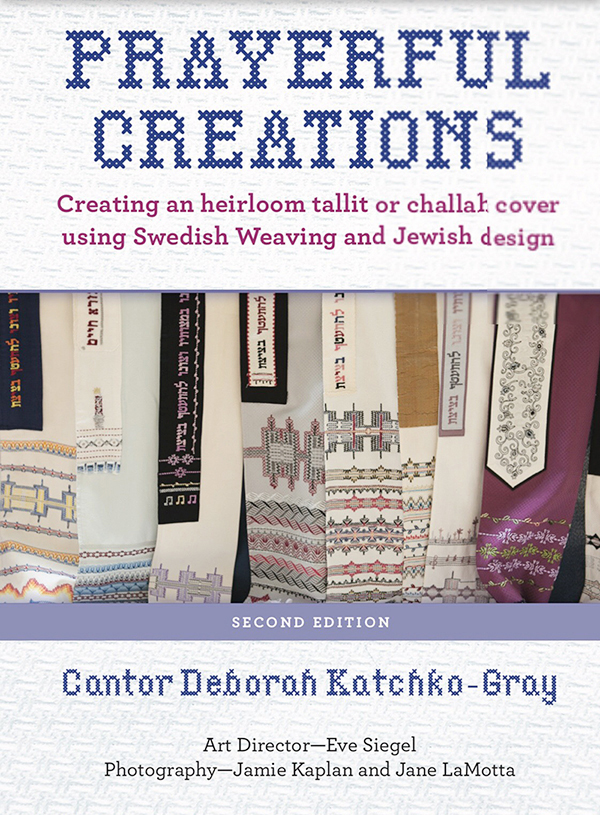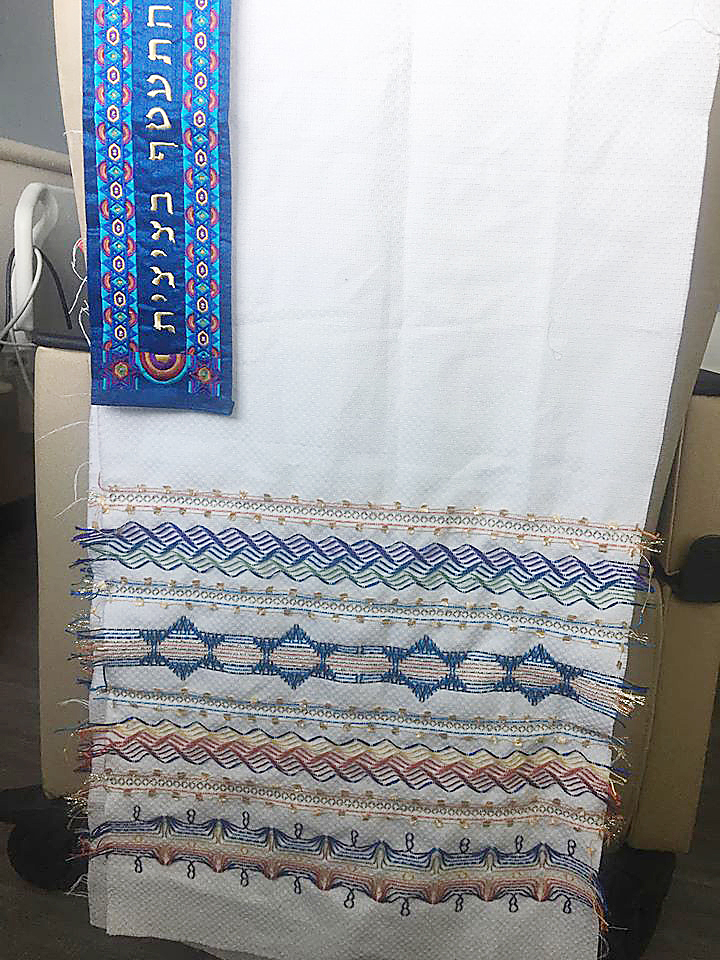
By Stacey Dresner
RIDGEFIELD – Cantor Deborah Katchko-Gray is known for her creativity as a musician, weaving her voice and the traditional arrangements of her ancestors into the beautiful Jewish prayers that she chants.
But her exquisite voice isn’t the only focus of Katchko-Gray’s masterful weaving. She also expresses her creativity by making exquisite tallitot (prayer shawls) through the art of Swedish Weaving, a decorate form of embroidery.
Over the past 25 years, Cantor Katchko-Gray estimates that she has created more than 100 tallitot for people in her family and congregants of Shir Shalom in Ridgefield, where she currently serves, and Beth El in Norwalk, where she previously served.

Now, Katchko-Gray takes her artistic talent to the next level with Prayerful Creations: Creating an Heirloom Tallit or Challah Cover Using Swedish Weaving and Jewish Design, her newly published book in which she shares the history of the tallit and teachers readers, through the step-by-step instructions, how to create a meaningful and personalized tallit using the Swedish weaving technique.
“Anyone can learn it,” she says. “I teach classes and usually when people start it they get hooked on it. They love it.”
To create her tallitot, Katcho-Gray uses a special kind of cotton called “Stockholm” or “popcorn” that is seven count (the number of threads per square inch).
“It is made in Austria and I am always buying it wherever I can find it in different colors,” she says. “I have huge bolts of this ivory color because I never want to run out of it.”
Katcko-Gray learned Swedish Weaving more than 25 years ago from Ellen Temkin, a member of Beth El in Norwalk. Described by Katchko-Gray as “a very wonderful, creative person,” Temkin would later write the forward to Prayerful Creations.

Katchko-Gray using Swedish Weaving.
“She went to an embroidery convention and saw them doing this Swedish Weaving on cotton material using horizontal design, and she thought, ‘That would really work well for a tallit,’” the cantor explains. “Then she designed this beautiful Jewish star pattern and a Torah, and she started teaching women in the congregation in Norwalk how to do it.”
It wasn’t long before Katchko-Gray was hooked.
When the oldest of her four sons was eight or nine, she recalls, “I decided I really wanted to learn how to do this because I loved the idea of making tallitot for my four sons and other members of the family, and that at each bar mitzvah I would have a row and then another row of of these beautiful, homemade tallitot.”
Over the years, Katchko-Gray developed some of her own designs and techniques and also began teaching the technique in classes she calls, “Stitch and Kvitch.”
“There was a national class called Stitch and B****, and I thought I can’t use that,” she laughs, “so I called it Stitch and Kvitch.”
Today, she continues to make tallitot, many of which are commissioned orders.
“I treasure the tallit that Debbie made for me,” says Alice Gottlieb, a congregant of Shir Shalom. “The quality is the best. She matched the design and color to my desires. Each tallit is unique.”
She often personalizes her tallitot with pieces of fabric offered by the families.
“I started that by putting pieces of my sons’ baby blankets in the four corners,” she says. “And then I thought about it and thought this could work for other things.”
When Rabbi David Reiner arrived at Shir Shalom, she wanted to make him a tallit. His mother had passed away two years earlier and she asked the rabbi’s father for something from his late wife to put on the tallit.
“He brought me the jacket that his wife had worn at their son’s bar mitzvah. And so, I’ve used this jacket on two tallit, a Torah binder, a baby quilt for his son, a tallit bag for him and I still have more fabric. They just had another son and I’ll be able to make his sons’ tallitot using the fabric from their grandmother’s jacket.”
She has created tallitot containing pieces of a tie from a father or grandfather, a handkerchief from a grandmother, and recently made one with a piece of the dress that the child’s mother wore at her own bat mitzvah and a piece of the dress her grandmother had worn at her mother’s wedding.
Another special thing she does for these tallitot is to cross-stitch the Hebrew names of the b’nai mitzvah, their parents, and even grandparents.
“I explain to them… in 20 years when you are holding this tallit, some of these people might not be here but you will have a piece of their fabric and you will always have a reminder of your childhood. What a beautiful way to pray and really be enveloped by your family,” she notes.
“Cantor Debbie’s beautiful handiwork truly captures our family in the fabric,” says Stacey Rubinfeld. “Worn for the very first time at their bar and bat mitzvahs, Cantor Debbie has created prayerful designs for my children that integrate meaningful pieces from various family members. She creates treasured works of art. There is nothing more special than tallit made by Cantor Debbie!”
She estimates that it takes her about 20 hours to make a regular tallit, and then probably another 20 hours for the cross-stitching.
She also makes tallit bags, challah covers, table runners and placemats as gifts.
She says she enjoys this kind of creative outlet.
“I’ve always thought of myself as a creative music person, but I like the hands-on [aspect of weaving]. When I started doing this embroidery, I’d never done needlework. But something about this, about creating prayer shawls as a cantor, really resonates with me,” she says.
She adds that this kind of creativity offers stress relief.
“I love doing it; it’s like a meditation,” she says. “It’s very relaxing. When you’re creating, just like if you are singing or making music, your mind goes into a different place and you really don’t think about anything but what you’re doing. I never thought I’d be a good candidate for meditation because I wasn’t sure I could ever quiet my mind, but when I’m doing this, I’m really focused on the task, and it does put you into a beautiful place.”







 Southern New England Jewish Ledger
Southern New England Jewish Ledger













